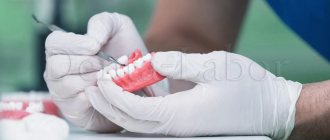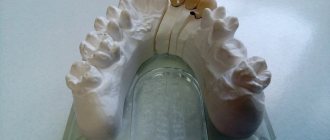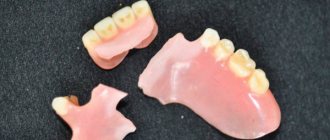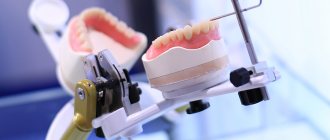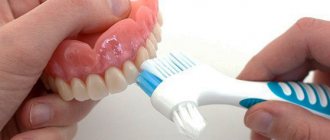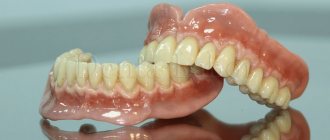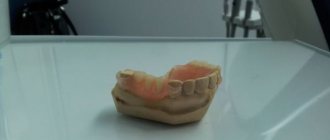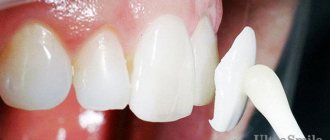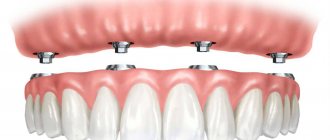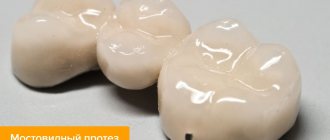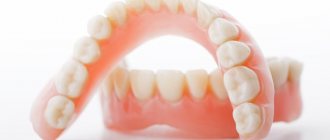Removable dentures are a common method of dental restoration in modern dentistry. Most often, removable dentures are used for dental restoration in elderly people. The method of dental prosthetics using removable dentures helps you quickly return to your previous active life without discomfort, and also restores the beauty of your smile. It will only take you a few days to get used to the dentures. We will also tell you how to speed up this process in the article. If you want to read about addiction right now, click on the link. Removable dentures fully reproduce the main function of teeth - crushing and chewing food.
Caring for removable dentures
Although a removable denture is an artificial structure, it still requires careful and high-quality care, because in fact, after installation, it becomes part of your body. Proper care of removable dentures guarantees comfortable wearing of the structure and its durability.
There are rules that must be followed for those who want to keep their dentures for a long time.
Rules for caring for removable dentures
After each meal, try to remove the denture to rinse it under running water. This not only ensures the comfort of wearing the denture (small particles of food remaining under the structure are very disturbing), but also guarantees the protection of the gums from the effects of pathogenic bacteria. Those pieces of food that remain under dentures are a breeding ground for microbes that can cause gum disease.
Cleaning a removable denture should be done with a soft-bristled toothbrush so as not to damage the integrity of the structure. When cleaning, special attention should be paid to: the part that is in direct contact with the gum, areas near the salivary gland canals, the front part of the lower jaw dentures and the side part of the upper jaw denture.
You can use regular toothpastes to clean your dentures. But try not to clean your dentures with whitening toothpaste. Such pastes contain strong abrasive substances that can damage the material of the structure.
Before going to bed, after the adaptation period has passed, the denture should either be left in the mouth or removed. You should clean your denture not only after each meal, but also before going to bed. It is necessary to store dentures at night in purified water (even boiled water will do) or a special composition that you can buy in pharmacies.
In case of breathing problems, sleep disorders, snoring and teeth grinding, dentures must be removed at night. If you are absolutely sure that you have one of the listed diseases, tell your dentist about it at your appointment. You will be recommended a treatment that will relieve you of your sleep problems. If you are concerned about your prosthesis or are just about to start prosthetics, we suggest you contact our Dentistry clinic on Shchelkovskaya Diamed. Convenient location, attentive doctors, and extensive experience in working with removable dentures guarantee you the accuracy of the work performed and the comfort of wearing a removable denture. You can sign up for the clinic by calling 8 or using the online registration form.
Eating with removable dentures
Caring for removable dentures involves regular disinfection. The prosthesis is placed in water in which a special disinfectant capsule is dissolved. It is enough to place the prosthesis in the prepared solution for only fifteen minutes.
To maintain the beautiful appearance of the prosthesis for as long as possible, try to consume less products with dyes, as well as tea, coffee, wine and other alcohol. Smoking also significantly increases the likelihood of darkening and discoloration of the denture. Avoid getting sticky food (taffy, chewing gum) on your dentures. Crackers, hard nuts, ice - all this should not be chewed if you do not want the prosthesis or artificial tooth to break.
Where to contact
Patients with removable orthopedic devices are recommended to see an orthopedist every 6 months
for relocation of the structure. This must be done for preventive purposes, since due to a violation of the fixation of the orthopedic system in the mouth, breakage of the structure, rapid loosening and loss of supporting teeth (with partial structures) may occur.
To restore a prosthesis in Moscow, it is most convenient to contact the RUTT network of clinics. Relining is carried out using modern cushioning materials from reliable manufacturers, which guarantees precise fit of the restored structure, uniform distribution of the chewing load, and long service life.
Expert of the article Alekperov Roman Borisovich Dentist-orthopedist, doctor of the first category
Work experience24 years
Getting used to removable dentures
As a rule, getting used to removable dentures takes some time. But after the “grinding in” period, a person already perceives the prosthesis as an integral and irreplaceable part of his body.
How long does it take to get used to dentures?
On average, the period of adaptation to dentures for a patient lasts thirty days. At first, dentures feel like a foreign body in the oral cavity, but this is quite natural, because a removable denture is an orthodontic structure. At first, removable dentures may even impair diction. This is especially difficult for people who, due to duty or other life circumstances, regularly communicate in foreign languages. But soon you will get used to it and your speech will be restored.
The presence of an orthodontic structure in the oral cavity initially disrupts the process of salivation and prevents a person from objectively assessing the taste and temperature properties of the food consumed. Also, during meals in the first month of wearing removable dentures, it may be difficult for a person to bite off solid food and chew a piece.
Caring for removable dentures also takes some getting used to. To help you remember, try posting reminders of what needs to be done. Over the course of some time, caring for removable dentures will become automatic.
But there is no need to worry and worry in all of the above cases. Typically, the patient’s symptoms of getting used to a removable denture disappear during the first week of wearing. Within a month, you will physically stop noticing the removable denture and will not consider it a foreign body. Moreover, most patients note that after an adjustment period they feel more comfortable with dentures in the mouth than without them.
How to quickly get used to removable dentures
The main condition for quickly getting used to removable dentures is their constant use despite some discomfort. It's worth it - it's better to wait one week and then enjoy a quality and comfortable life. There are several recommendations and tricks that will help the body go through the adaptation period faster.
During the adjustment period, before placing the denture in the oral cavity, moisten it with water or apply a special fixative to its surface. Practice putting on and taking off removable dentures first, so that later this action becomes mechanical. If you start to feel nauseous, suck on a small piece of candy by pressing your tongue against the roof of your mouth.
For up to two weeks, when you get used to the dentures, do not take them off even at night. They should only be removed to clean the mouth and the denture itself. Reading aloud for two hours in a quiet environment will again help “tune” your diction. This exercise restores the articulation of sounds in five to six days. Rinse your mouth with warm water about eight times a day and drink hot tea more often. Cut foods into small pieces before eating. It is better to chew food with your lateral teeth, both left and right at once. Eat more vegetables and fruits.
Types of relining material
Correction of removable laminar dentures involves the use of the following materials:
- Hard plastic
– cold-curing acrylics (Protacryl, Redont), hot-curing acrylates (Ethacryl, Ftorax, etc.), polymethyl methacrylate. Solid base plastics are used for rigid fixation of orthopedic systems or laboratory relocation. - Soft composites
– acrylic, silicone elastomers. It is used if the physical parameters of the orthopedic device are normal, but the patient experiences headaches and discomfort. Typically used for relining mandibular prosthetic structures. - Temporary elastics
(conditioners) – polyvinyl chlorides and silicone base materials are highly elastic and are used for soft relining of dentures in case of systematic inflammation of the gums. Elastic materials are characterized by particular softness and are intended to reduce and uniformly redistribute chewing pressure to sensitive areas of the mucosa. Temporary material should be regularly updated, as it reacts negatively to cleaning agents and is susceptible to the accumulation of bacterial plaque.
The cost of relining an orthopedic system depends on several parameters - the technology used, material, type (clasp, conditionally removable, removable), size of the prosthesis, etc.
Features of wearing removable dentures
Removable dentures have some features. When designing removable dentures, it is impossible to take into account several factors that can only appear while wearing the dentures. This is the degree of pressure of the prosthesis on the gum and the degree of fixation of the prosthesis. It happens that at first patients are concerned about pain when wearing dentures.
Correction of removable dentures
Correction of removable dentures - grinding of the structure in places of contact with the oral mucosa - is carried out the next day after installation of the denture. During the first two weeks of wearing the structure, several adjustments to the prosthesis may be required.
The correction procedure is carried out in the dental office by the attending dentist. Before visiting a doctor to have your denture adjusted, be sure to wear it and walk around with it for at least three to four hours. Also, do not carry out self-correction of a removable denture using improvised tools. At best, this will completely disrupt the fixation of the prosthesis, and at worst, it will lead to a breakdown, after which it is impossible to restore the structure - you will have to make a new one.
If the denture rubs the gum
Some patients, when wearing dentures for the first time, complain that the structure rubs their gums. This is the result of the oral cavity “getting used to” a foreign object. In order to get rid of unpleasant sensations, consult a doctor - he will correct the prosthesis. Don't tolerate discomfort. In the place where the prosthesis rubs, an inflammatory process can form, and healing due to constant friction is almost impossible. If you cannot get to the orthopedist who installed the prosthesis for you, you can turn to us for a service - at the clinic on Shchelkovskaya. An experienced specialist will see you and help you adjust the prosthesis so that nothing bothers you. Just call 8 (495) 033-00-63 or leave your details in the registration form on our website.
Fixation of the prosthesis
The anatomical features of the jaw structure in some people create obstacles to comfortable wearing of dentures. In such cases, you can use a special fixing gel, which is applied in a thin line to the prosthesis. This gel is completely invisible to humans and is absolutely safe. It is better to choose a gel in consultation with your doctor.
Broken prosthesis
During the use of prostheses, due to various factors, the prosthesis may break, as well as cracks and chips. In such cases, you must immediately consult a doctor to repair the structure. The repair period for a prosthesis is up to three days; making a new design (if the old one cannot be corrected) takes a week.
Indications for correction
A removable denture, whether partial or complete, requires repair or modification when it is broken, misaligned, worn down by either the teeth or underlying material, or has fracture lines that may develop into an actual fracture. If it is loose, the liner may need to be changed to improve the fit's proximity to different elevations and gum tissues. This may help prevent mucosal growths known as inflammatory hyperplasia. If the clasps and supports are broken, they may need to be repaired or even replaced because they help support the denture and prevent it from settling into the gum.
An ill-fitting or broken denture can lead to inflammation, soreness, difficulty speaking and chewing, and very serious health problems. This device and the entire oral cavity should be examined at least once a year, since serious problems do not always cause pain and discomfort.
The oral cavity naturally changes with age, which can affect the fit of a removable partial denture. The bony ridges may compress to create a space underneath. Food may get stuck in it. Clamps can also become damaged from wear and tear. Anything that affects the close fit of a removable partial denture can cause irritation and ulcers.
If it needs adjustment, you cannot configure it yourself at home. Because in this way you can harm both the device and your own health.
A poorly adjusted partial denture can cause sores and irritation.
Service life of removable dentures
If you follow the rules and provide regular care for your removable dentures, the design will last you a long time. The minimum service life of prostheses is three years. The production of new prostheses after a certain period of time is extremely necessary - wearing outdated structures causes bone tissue atrophy and “sagging” of the lower part of the face.
When wearing removable dentures, it is important to visit a dentist at least twice a year. The doctor relines the prosthesis - restoring a tight fit of the prosthesis to the jaw. The doctor also examines the general condition of the oral cavity, which allows timely detection and treatment of inflammatory processes.
If you feel severe discomfort while wearing removable dentures, dry mouth, pain, then contact your dentist as soon as possible - he will help identify the causes of symptoms and carry out the necessary restorative procedures.
When is denture relining necessary?
After fixing the new orthopedic system, after the first 1-3 months
wearing, relining the denture is necessary to correct the accuracy of its fit to the mucosa. Because the teeth were missing for some time, the jaw joint was rebuilt. After installing the prosthetic structure, the load on the jaw tissue changes. It begins to gradually atrophy, the gums sag, and the bite begins to change. The prosthesis becomes uncomfortable and the occlusion is disrupted.
Relocation shown:
- if the structure does not hold well in the mouth, falls out during conversation, eating, or puts pressure on the gums;
- in the presence of defects in the prosthetic system due to violations of technology during impression taking or manufacturing;
- deterioration of the aesthetic characteristics of the structure;
- the prosthesis has been damaged or has flaws;
- the shape of the alveolar process has changed, which caused instability of the orthopedic structure;
- an atypical change in the height of the lower part of the face was detected (even if the deviation is minimal from the original parameters).
Correction is needed not only for removable models, but also for conditionally removable structures supported by implants. Mostly, these are single-stage protocols with instant load (all-on-4, all-on-6). After implantation of implants and installation of a prosthetic system, the load on the bone increases. This leads to enhanced regeneration of bone tissue and an increase in its parameters, which requires correction of the orthopedic apparatus. That is, if the bite changes, the position of the prosthetic system changes.
Loss of an artificial tooth from a prosthesis
The orthopedic dentist takes an impression of the patient’s mouth along with the prosthesis and sends it to the dental laboratory. The dental technician makes a plaster model based on the impression, on which a plastic prosthesis is already placed. Its edges are slightly polished using a milling cutter. An artificial tooth is selected based on color and size, the plastic is diluted, and at the required stage of its maturation, it is applied to the model in the area of the missing element. The tooth is placed on the dough-like consistency, all edges are smoothed, the denture is placed in cold water for 10-15 minutes to polymerize the plastic. After some time, the dental technician processes and polishes the repair area.
Clinical method of prosthesis correction
If the denture bed does not coincide with the base due to the presence of defects or due to a decrease in the jaw bone, relining is required. To reline the prosthesis, specialists use clinical and laboratory methods.
The prosthesis is polished following the marks left by the articulation paper.
It includes the following steps:
- First, the doctor places articulating paper between the patient’s teeth, asks him to bite it and looks at which areas are colored black. He polishes them carefully
- Then, from the side of the structure that is adjacent to the gum, part of the material (about 1 mm thick) is removed.
- The polishing is removed from the vestibular part of the structure and Vaseline is applied to the crowns.
- Prepare a special polymer composition, cover the base with it, distributing it over the entire surface. The mass hardens on its own
- After a few seconds, the prosthesis is placed on the jaw. Excess material is squeezed out onto the surface of the base in the area of the soft palate. They are removed with a special spatula
- The denture is then removed from the mouth and sent to a polymerization machine.
After relining using the clinical method, a clear imprint of the gum remains on the surface, so the structure fits tightly to it, accurately following the contours of the jaw. In about an hour the product will be completely ready.
